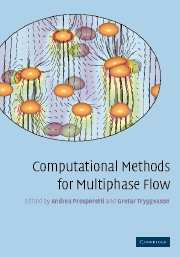Book contents
- Frontmatter
- Contents
- Preface
- Acknowledgments
- 1 Introduction: A computational approach to multiphase flow
- 2 Direct numerical simulations of finite Reynolds number flows
- 3 Immersed boundary methods for fluid interfaces
- 4 Structured grid methods for solid particles
- 5 Finite element methods for particulate flows
- 6 Lattice Boltzmann models for multiphase flows
- 7 Boundary integral methods for Stokes flows
- 8 Averaged equations for multiphase flow
- 9 Point-particle methods for disperse flows
- 10 Segregated methods for two-fluid models
- 11 Coupled methods for multifluid models
- References
- Index
7 - Boundary integral methods for Stokes flows
Published online by Cambridge University Press: 07 December 2009
- Frontmatter
- Contents
- Preface
- Acknowledgments
- 1 Introduction: A computational approach to multiphase flow
- 2 Direct numerical simulations of finite Reynolds number flows
- 3 Immersed boundary methods for fluid interfaces
- 4 Structured grid methods for solid particles
- 5 Finite element methods for particulate flows
- 6 Lattice Boltzmann models for multiphase flows
- 7 Boundary integral methods for Stokes flows
- 8 Averaged equations for multiphase flow
- 9 Point-particle methods for disperse flows
- 10 Segregated methods for two-fluid models
- 11 Coupled methods for multifluid models
- References
- Index
Summary
Boundary integral methods are powerful numerical techniques for solving multiphase hydrodynamic and aerodynamic problems in conditions where the Stokes or potential-flow approximations are applicable. Stokes flows correspond to the low Reynolds number limit, and potential flows to the high Reynolds number regime where fluid vorticity can be neglected. For both Stokes and potential flows, the velocity field in the system satisfies linear governing equations. The total flow can thus be represented as a superposition of flows produced by appropriate point sources and dipoles at the fluid interfaces.
In the boundary integral approach the flow equations are solved directly for the velocity field at the fluid interfaces, rather than in the bulk fluid. Thus, these methods are well suited for describing multiphase systems. Examples of systems for which boundary integral algorithms are especially useful include suspensions of rigid particles or deformable drops under Stokes-flow conditions. Applications of boundary integral methods in fluid dynamics, however, cover a broader range. At one end of this range are investigations of the hydrodynamic mobility of macromolecules; at the other end are calculations of the flow field around an airplane wing in a potential flow approximation. Here we will not address the potential flow case, limiting ourselves to Stokes flow.
Introduction
In the present chapter we discuss boundary integral methods for multiphase flows in the Stokes-flow regime. We review the governing differential equations, derive their integral form, and show how to use the resulting boundary integral equations to determine the motion of particles and drops. Specific issues that are relevant for the numerical implementation of these equations are also described.
- Type
- Chapter
- Information
- Computational Methods for Multiphase Flow , pp. 193 - 236Publisher: Cambridge University PressPrint publication year: 2007
- 1
- Cited by



